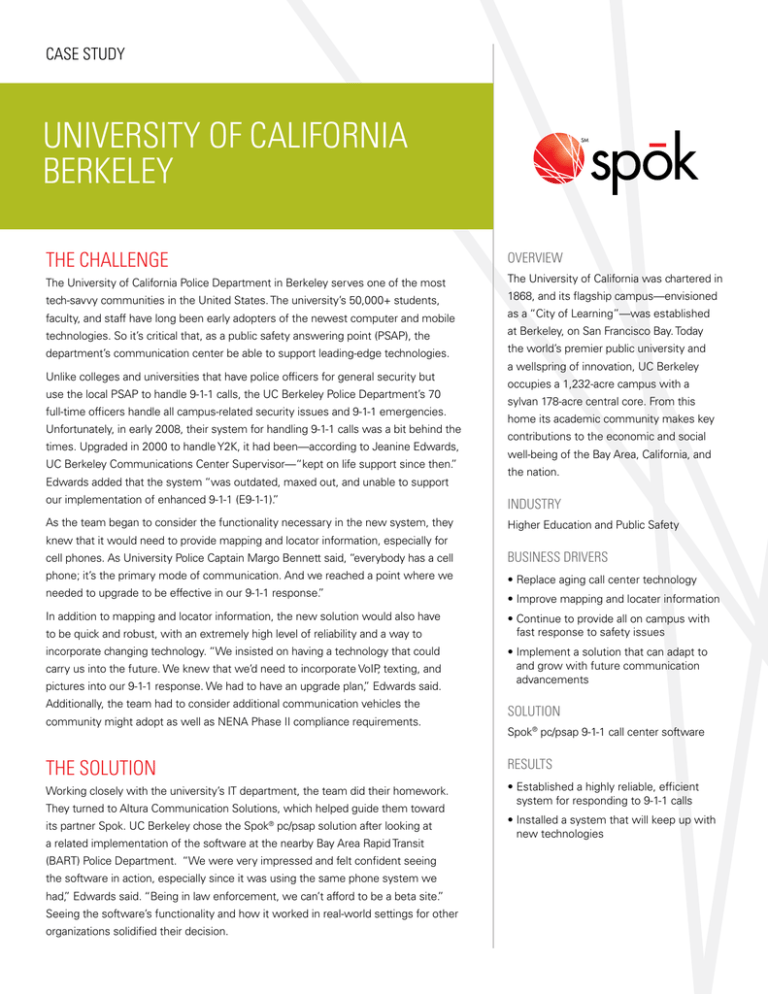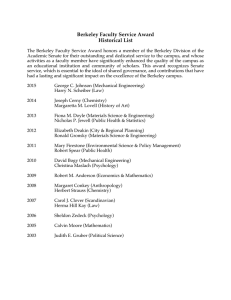
CASE STUDY
UNIVERSITY OF CALIFORNIA
BERKELEY
THE CHALLENGE
The University of California Police Department in Berkeley serves one of the most
tech-savvy communities in the United States. The university’s 50,000+ students,
faculty, and staff have long been early adopters of the newest computer and mobile
technologies. So it’s critical that, as a public safety answering point (PSAP), the
department’s communication center be able to support leading-edge technologies.
Unlike colleges and universities that have police officers for general security but
use the local PSAP to handle 9-1-1 calls, the UC Berkeley Police Department’s 70
full-time officers handle all campus-related security issues and 9-1-1 emergencies.
Unfortunately, in early 2008, their system for handling 9-1-1 calls was a bit behind the
times. Upgraded in 2000 to handle Y2K, it had been—according to Jeanine Edwards,
UC Berkeley Communications Center Supervisor—“kept on life support since then.”
Edwards added that the system “was outdated, maxed out, and unable to support
SM
OVERVIEW
The University of California was chartered in
1868, and its flagship campus—envisioned
as a “City of Learning”—was established
at Berkeley, on San Francisco Bay. Today
the world’s premier public university and
a wellspring of innovation, UC Berkeley
occupies a 1,232-acre campus with a
sylvan 178-acre central core. From this
home its academic community makes key
contributions to the economic and social
well-being of the Bay Area, California, and
the nation.
our implementation of enhanced 9-1-1 (E9-1-1).”
INDUSTRY
As the team began to consider the functionality necessary in the new system, they
Higher Education and Public Safety
knew that it would need to provide mapping and locator information, especially for
cell phones. As University Police Captain Margo Bennett said, “everybody has a cell
BUSINESS DRIVERS
phone; it’s the primary mode of communication. And we reached a point where we
•Replace aging call center technology
needed to upgrade to be effective in our 9-1-1 response.”
In addition to mapping and locator information, the new solution would also have
to be quick and robust, with an extremely high level of reliability and a way to
incorporate changing technology. “We insisted on having a technology that could
carry us into the future. We knew that we’d need to incorporate VoIP, texting, and
pictures into our 9-1-1 response. We had to have an upgrade plan,” Edwards said.
Additionally, the team had to consider additional communication vehicles the
community might adopt as well as NENA Phase II compliance requirements.
THE SOLUTION
Working closely with the university’s IT department, the team did their homework.
They turned to Altura Communication Solutions, which helped guide them toward
its partner Spok. UC Berkeley chose the Spok® pc/psap solution after looking at
a related implementation of the software at the nearby Bay Area Rapid Transit
(BART) Police Department. “We were very impressed and felt confident seeing
the software in action, especially since it was using the same phone system we
had,” Edwards said. “Being in law enforcement, we can’t afford to be a beta site.”
Seeing the software’s functionality and how it worked in real-world settings for other
organizations solidified their decision.
•Improve mapping and locater information
•Continue to provide all on campus with
fast response to safety issues
•Implement a solution that can adapt to
and grow with future communication
advancements
SOLUTION
Spok® pc/psap 9-1-1 call center software
RESULTS
•Established a highly reliable, efficient
system for responding to 9-1-1 calls
•Installed a system that will keep up with
new technologies
CASE STUDY
Once installed, the 9-1-1 public safety system impressed Edwards and Bennett. It integrated
smoothly with their Avaya® PBX system. It was, according to Edwards, “bigger, badder, and
faster,” and she was happy that her team of 10 dispatchers quickly embraced the system and
enjoyed working with it.
Two key goals in implementing the overall system were to identify wireless callers and to
continue to use important location data that had been developed by the University Police
Department. Spok’s expertise in local automatic location identification (ALI) database
integration and standard NENA 2 format data delivery to a customer’s chosen mapping
“I feel the [Spok]
system will grow
with us and help us
address changes as
they occur.”
platform made it easy to achieve these goals. Using the system’s auxiliary data function,
Edwards modified the automatic number identification (ANI) database, inputting descriptions
Jeanine Edwards
UC Berkeley Communications
Center Supervisor
that made sense to her team. “We’re not a regular city with regular streets,” she said. “In cases
where we don’t have a building address, we can include data such as the ‘pathway between the
bridge and the walkway’ so responding officers know precisely where to go.”
Another benefit of the system is the ability to transfer calls in a single click. The communication center
handles approximately 1,200 calls a month, but not all are emergencies. Non-emergency calls can now
quickly be rerouted to the appropriate resource, freeing operators for more urgent situations.
THE RESULTS
Today, Spok pc/psap transmits the precise caller location for 16,260 campus Centrex lines; 3,664 campus
dorm lines; 481 elevator, entry, and code blue emergency phones; and 231 main business lines throughout
the campus. While the new system has brought peace of mind to both Bennett and Edwards, it’s helped in
other ways, too. “We are very data-driven in the decisions that we make,” Bennett said. “And the system’s
ability to track calls, give locations, give stats on days-of-week and time-of-day helps us figure out how best
to staff the communication center. It also gives patrol information on how to staff different sectors around
campus.”
Now when callers use cell phones to dial 9-1-1, Spok pc/psap passes the ALI stream to a mapping system
in the correct format to map the call using the coordinates of nearby cell towers to zero in on the caller’s
location. This is a great improvement over the previous process which involved the California Highway Patrol
receiving cell phone-based 9-1-1 calls and involving the UC Berkeley police team to resolve them. “It’s a
quicker, more streamlined way to respond to these calls,” Bennett said. “This was why integrating to the
mapping functionality was so critical for us.”
Even the admissions department has benefited, as the system has helped reassure students and their
parents. Noted Bennett, “Since the Virginia Tech incident, parents want to know how we handle emergencies,
how responsive we are, and how we get things done.”
With the new system in place, Edwards and Bennett are comfortable they can now provide the appropriate
police response needed to help keep their large community safe. But more importantly, as a major university
campus where students and staff are first to embrace the next technological advancement, Edwards is
confident UC Berkeley has a solution that will help them move forward. “I feel the [Spok] system will grow
with us and help us address changes as they occur.”
spok.com
© Spok, Inc. 2010, 2014 All Rights Reserved. Spok is a trademark of Spok Holdings. Other names and trademarks may be the property of their
respective owners.


